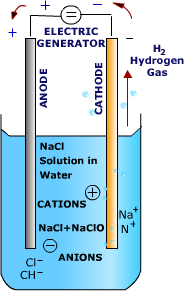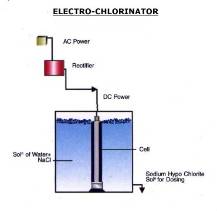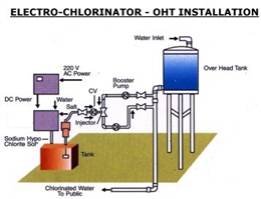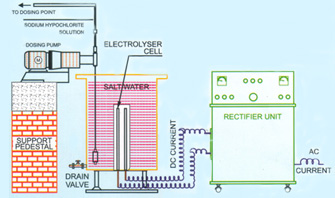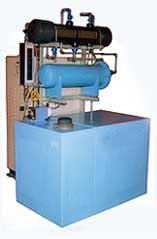| Products > Water Disinfection System >Chemicalized Disinfection >> |
|
Aquachlor-Gen™ :- |
 |
|
| |
| |
| |
| Introduction:- |
 |
|
| |
We manufacture AquachlorTM -Gen i.e. Electro-chlorinator which produces Sodium hypochlorite on-site which will be use as disinfectant in many of application.
Sodium Hypochlorite, a strong oxidizing agent, is produced by the process of electrolysis of salt water. Electrochlorinator is used as an alternative to chlorine gas for disinfection of Domestic Water Supply, Cooling Towers, Swimming Pools, Power Stations for control of bio fouling, Disinfection of Ballast Water in Ships, Fire Water System, Fountain Water etc.
Sodium Hypochlorite will be generated on-site with the help of synthetic brine or seawater is very efficient in protecting the equipment from the growth of micro organic fouling and control of algae and crustaceans.
Portable model Electrochlorinators manufactured by SHIVAM are ideal for disinfection of water during disasters like earthquakes, Floods or Epidemics. Electrochlorinators are designed for rural and village 'point -of- use' disinfection of drinking water. |
| |
Working Principle:- |
 |
|
| |
Electrochlorinator requires only salt, water and electricity. Electro chlorinator Provides the power of Chlorine without the danger of storing or handling hazardous materials.
Sodium hypochlorite generated on-site does not degrade like commercial sodium hypochlorite.
The total operating cost of Electrochlorinator is less than the conventional Chlorination methods.
On-site generation of sodium hypochlorite allows the operator to produce only what is needed and when it is needed. |
| |
|
| |
| (On-Site Sodium Hypochlorite Generator) |
| |
- Electro Chlorination is the name given to the process whereby an electrical current is used to convert sodium chloride (salt) solution to sodium hypochlorite or chlorine.
- Salt solution is passed through the SHIVAM’s electrolyzer cells where it is electochemically transformed into sodium hypochlorite.
|
| |
|
| |
2Nacl (Salt) + H2O (Water) + Energy =NaOCl (hypo) + NaCl (Salt) + H2 (Hydrogen) |
| |
Types of ElectroChlorinator:- |
 |
|
| |
| Batch Production Electro Chlorinators:- |
| |
Description :-
Batch production electrochlorinators are designed for small capacities and are available from 15 gms/hr to capacity of 500 gms/hr chlorine equivalent. Production of Sodium Hypochlorite is completed in a batch of every 8 hours, to concentration of around 6-8 gms/litre.
Basic System Components:
Electrolyser Cell, Rectifier, Storage Tank and Dosing Pump.
Operation:
A metered amount of water is mixed with common salt to form brine of required concentration [or Seawater is used]. This is the electrolyte used in the process. Electrolyser Cells are dipped in this measured quantity of Brine Solution, contained in a specially made FRP Tank.
These cells are connected to a rectifier, which converts Alternate current to Direct current. When DC Current passes through these electrode assembly, Sodium Hypochlorite evolves instantaneously with negligible quantities of hydrogen rising up to the surface, which is vented out. This process is based on the chemistry of Electrolysis of Sodium Chloride. The Sodium Hypochlorite thus generated is collected in a storage Tank and applied directly or pumped to the point of application. |
| |
|
| |
| AQUACHLOR- GENTM -100 : 5,50,000 Liters water with 2 ppm dosing, disinfection / 8 hrs working. |
| |
| MODEL |
AQUACHLOR- GENTM -100 |
RATED PRODUCTION CAPACITY |
1.1KG/8 HRS.BATCH AVAILABLE CL2 |
MODE OF PRODUCTION |
8 HRS.BATCH |
HYPOCHLORITE STRENGTH |
8 GMS/LITER (APPROXIMATE) |
WATER CONSUMPTION / BATCH |
140 LITER |
SALT CONSUMPTION / BATCH |
4.5 KGS. |
A.C. INPUT |
230V, SINGLE PHASE OR 440V, THREE PHASE 50 Hz, 15 AMPS, AC SUPPLY WITH PROPER EARTH CONNECTION |
D.C.OUTPUT |
100 - 120 AMPS
4 – 12 VOLTS |
|
| |
| CONTINUOUS PRODUCTION ELECTROCHLORINATORS : |
| |
Description:
Continuous Production Electrochlorinators are On-Site Sodium Hypochlorite [Hypo] Generator designed for small / medium / large capacities.
Continuous Production Electrochlorinators are capable of producing from 500 gms/hr to 15Kgs/hr active chlorine using our unique Anodes and Electrochemical Process. Brine solution passes through an Online Electrolyser with inbuilt heat exchanger pack. This is connected to a DC Rectifier. When low voltage DC is passed through the Electrolyser Cell, Sodium Hypochlorite solution to concentration of 6-8 gms/litre approx. is evolved continuously. This can be stored in a Storage Tank and pumped / used at required rates.
Basic System Components:
Brine Solution Storage Tank/ Sea Water Tank, Brine/Seawater Pump, Electrolyser with inbuilt composite FRP Heat Exchanger or Chiller Plant, DC Rectifier, Hypo Storage Tank, necessary Instrumentation, pipes and fittings, and Dosing Pump and accessories.
Operation:
A metered amount of water is mixed with common salt to form brine of required concentration (or Seawater is used). This is the electrolyte used in the process. This electrolyte is pumped to Electrolyser cells, when DC Current passes through Anodes, Sodium Hypochlorite solution to concentration of 8 gms/litre approx. evolves continuously and this is collected in Hypo StorageTank and applied directly or pumped to the point of application at required rates. To maintain the temperature at correct levels, prevent dissipation and get correct concentration of Sodium Hypochlorite output, Brine/ seawater is cooled through a chiller or heat exchanger. |
| |
|
| |
| AQUACHLOR- GENTM -500 : 2,50,000 Liters water with 2 ppm dosing, disinfection / 8 hrs working. |
| |
| MODEL |
AQUACHLOR- GENTM -500 |
RATED PRODUCTION CAPACITY |
0.5KG/HR AVAILABLE CL2 |
MODE OF PRODUCTION |
CONTINUOUS |
HYPOCHLORITE STRENGTH |
7 GMS/LITER (APPROXIMATE) |
OPERATING PRESSURE |
1 KG / cm2 |
BRINE CONCENTRATION |
310 Gm/L |
CONCENTRATION WATER BRINE
SOLUTION INLET TO MIXER |
7 LITER / HR |
WATER INLET TO MIXER |
65 LITER / HR |
HYPOCHLORITE SOLUTION DISCHARGE |
72 TO 75 LITER / HR. (MAX.) |
A.C. INPUT |
230V, SINGLE PHASE OR 440V, THREE PHASE 50 Hz, 32 AMPS, AC SUPPLY WITH PROPER EARTH CONNECTION |
D.C.OUTPUT |
100 - 120 AMPS
0 – 30 VOLTS |
|
| |
| If water disinfection is more than 2,50,000 Lts / Hr. we can design our model accordingly. |
| |
|
| |
| Continues Electro-chlorinator |
| |
Note :
The above Tehnical Specification is for 500 Gms / Hr Electro Chlorinator. Specifications for other higher capacities can be provided, on your Engquiry. Each Electrochlorinator and its Accessories is Tailor-made as per specifice Client's requirements.
Features:
Safe:
No hazardous gas to store or handle. Concentration of 0.8% is classified as non-hazardous chemical, although a strong disinfectant.
Easy to operate and Maintain:
Very little operator training is required.
Field proven :
This technology is proven and time tested.
Lifecycle Service:
Assured after sales support by very responsive and responsible team.
Customized System:
Available in wide range of capacities and models and can be customized to suit individual customer's needs. |
| |
Advantages:- |
 |
|
| |
Although the economic consideration is the major advantage in using On- site generated Sodium Hypochlorite over the use of other forms of Chlorination, but the technical advantages are even greater.
The following are some of the problems associated with using commercial grade liquid sodium hypochlorite. These have high concentration (10-12%) of active chlorine. These are produced by bubbling gas chlorine in Caustic soda (Sodium Hydroxide). They are also commonly called as Liquid Chlorine.
Corrosion
The corrosion due to Commercially produced hypochlorite is a concern because of its effect on equipment. A 10 to 15% hypochlorite solution is very aggressive due to its high pH and chlorine concentration. Because of its aggressive nature, the hypochlorite solution will exploit any weakened areas in the hypochlorite piping system and may cause leaks.
Scaling
The formation of calcium carbonate scale is another concern when using commercial grade liquid hypochlorite for chlorination. Commercial grade liquid hypochlorite has a high pH. When the high pH hypochlorite solution is mixed with the dilution water, it raises the pH of the mixed water to above 9. The calcium in the water will react and precipitate out as calcium carbonate scale. Items such as pipes, valves and rotameters may scale up and no longer function properly. It is recommended that the commercial grade liquid hypochlorite not be diluted and that the smallest pipe lines, the flow rate will allow, should be used in the system.
Gas Production
Another concern with commercial grade hypochlorite is gas production. Hypochlorite loses strength over time and generates oxygen gas as it decomposes. The rate of decomposition increases with concentration, temperature, and metal catalysts.
Personal Safety
A small leak in the hypochlorite feed lines would result in the evaporation of the water and in turn the release of chlorine gas.
Chlorate Formation
The final area of concern is the possibility of chlorate ion formation. Sodium hypochlorite degrades over time to form the chlorate ion (ClO3-) and oxygen (O2). The degradation of the hypochlorite solution is dependent on the strength of the solution, temperature, and the presence of metal catalysts.
Decomposition of Commercial Sodium Hypochlorite can be created by two major ways:
a). The formation of Chlorates due to high pH, 3NaOCl= 2NaOCl+NaClO3.
b). Chlorine evaporation loss due to temperature increase.
Therefore, for any given strength and temperature, over a period of time, the higher strength product will eventually be lower in available chlorine strength than the lower strength product, since its decomposition rate is greater. The American Water Works Association Research Foundation's (AWWARF) concluded that the decomposition of concentrated bleach (NaOCl) is the most probable source of chlorate production. High concentration of Chlorate is not advisable in drinking water. |
| |
Applications:- |
 |
|
| |
SHIVAM has an Electro Chlorinator for every water disinfection application
- Electrochlorinators for Drinking Water
- Salt Chlorinators for Swimming Pools
- Chlorinators for Fountains and Water Parks.
- Sodium Hypochlorite Generator for Ballast Water in Ships.
- Sodium Hypochlorite generators for Rural application
- Hypo generator for Marine application
- Hypogenerators for Domestic application
- Chlorine generators for power plants.
- Cl2 generators of off-shore flat forms.
- Chlorine generators for ship.
- Portable water treatment for drinking purpose.
- Cooling water treatment and algae control.
- Effluent control including treatment of sewage.
- Decomposition of Cyanide waste in Electroplating and bulk drug plants.
- Open well water treatment.
- Hospital disinfection, hygiene maintenance and waste management.
- Sterilizer for food processing in Hotel and Restaurants.
- Meat and poultry processing facilities disinfection.
- Public Places disinfection.
- Public health water treatment to control micro-organisms, destroy hydrogen- sulphide (rotten egg odor), control algae growth and keeps transmission pipes clean.
- Laundry and bleaching.
- Poultry water disinfection.
- Dairy equipment sterilization.
- Manufacture of oxidized starch.
- Bleaching of textiles, paper shellac, carpets, alginates.
- Fisheries.
|
| Chlorine Comparison Chart |
Product Form |
PH Stability |
Available Chlorine |
Form |
C12 gas |
Low |
100% |
Gas |
Sodium hypochlorite(Commercial) |
13+ |
5-10% |
Liquid |
Calcium hypochlorite granular |
11.5 |
20% |
Dry |
Sodium hypochlorite(On-site) |
8.7-9 |
0.8-1% |
Liquid |
|
|
|
| |
| OPERATING COST COMPARISON: |
| |
Operational Cost Comparison for:
Chlorine Gas
VS
Bleaching Power
VS
Ready Made Hypochlorite Solution ( Commercial Sodium Hypochlorite )
VS
On-Site Sodium Hypochlorite Generators, AQUACHLOR-GENTM
Electrochlorinator |
|
| |
| Eg : Working on 2000m3 Of Water to be Chlorinated with 2 PPM dosing for each application |
|
Chlorine Gas |
Bleaching Powder |
Ready Made Hypochlorite Solution |
On-Site Hypochlorite using Aquachlor-Gen. |
Total quantity of water to be Chlorinated with 2 ppm Dosing. |
2000m3/day |
2000m3/day |
2000m3/day |
2000m3/day |
Total quantity of the Substance Used. |
4 Kg /day |
65 Kg /day |
140 liters /day |
18 Kg Salt & 18 KWH of Electricity. |
Cost /Day |
US $ 12.8
(1 Kg @$ 3.2 ) |
US $ 20.54
(1 Kg @ $ .316) |
US $ 19.6 ,
(1 liter @ $ $.14 ) |
Rs US $ 2
[ Salt,
(1 Kg @ $.02 ),
Electricity , 1KWH @ $ .09 )] |
Cost/Month |
US $ 384 |
US $ 616.2 |
US $ 588 |
US $ 60 |
Cost/Year |
US $ 4608 |
US $ 7394.4 |
US $ 7056 |
US $ 720 |
Net Saving By Using AQUACHLOR – GEN ELECTROCHLORINATOR. |
US $ 4608 - US $ 720 == US $ 3888 |
US $ 7394.4 - US $ 720 == US $ 6674.4 |
US $ 7056- US $ 720 == US $ 6336 |
The Most Economical. |
Operating Cost per 1000 liter in Rs |
US $ .0064 |
US $.0102 |
US $ .0098 |
US $.001 |
|
|
| COMPARATIVE ADVANTAGES OF ELECTRO-CHLORINATOR :- |
| |
| Technical Comparison of Electrochlorinator with Bleaching powder, readymade hypo and Chlorine Gas. |
| |
| Factor |
Chlorine Gas |
Commercial Hypochlorite |
Bleaching
Powder
|
SHIVAM generated onsite hypochlorite |
SAFETY |
Chlorine is a dangerous gas |
Is a hazardous chemical |
Is a hazardous chemical |
Concentration less than 1% and completely safe to handle |
CORROSIVE NATURE |
Highly corrosive |
Highly corrosive |
Highly Corrosive |
Not corrosive due to low concentration |
TRANSPORTATION |
Difficult to transport due to hazardous nature |
Difficult to reach remote locations |
Difficult to reach remote locations |
Generated onsite. No transportation required |
STABILITY |
Stable but wastage cannot be avoided |
Highly unstable |
Highly unstable |
Stable |
DOSING ACCURACY |
Possible |
Not possible due to unstable nature |
Not possible due to unstable nature |
Can dose accurately |
USER FRIENDLY |
No. Operators scared to use. Requires plethora of safety equipments. |
No. Chemical requires safe handling |
No. Requires safe handling |
Yes. No safety requirements. Concentration below hazard limit |
|
SEND IN YOUR ENQUIRIES WITH FOLLOWING DETAILS
- "Back pressure in the Chlorine solution discharge line / point of dosing.
- " Residual ppm of Chorine required / Volume of water /Flow rate of water to be treated.
- " Purpose for which this system is to be used. Drinking water / Waste water/ Cooling water / Other special Applications.
- " If servicing of other make Electro Chlorinators are to be done, please specify make, year of manufacture and nature of problems.
SOME use full links:-
1. Chlorine bleach, sodium hypochlorite (NaOCl), is a very useful and inexpensive disinfectant. A disinfectant kills germs that can make people sick. Sodium hypochlorite is just one of the common chlorine disinfectants;
www.americanchemistry.com/s_chlorine/sec_content.asp?CID=1243&DID=4721 - 15k –
2.
CHLORINE GAS VERSUS SODIUM HYPOCHLORITE
Despite the outstanding safety record of the chlorine gas some water companies are considering converting their disinfection systems from chlorine gas to sodium hypochlorite due to the perceived safety benefit.
http://wioa.org.au/conf_papers/04/paper2.htm
3. Our investigations have shown sodium hypochlorite to be effective and have broad applications. We have investigated a number of other disinfectants (calcium hypochlorite, ozone, UV, solar disinfection) and treatment processes (filters, slow sand filtration) and feel that sodium hypochlorite offers the best mix of low cost, ease of use, safety, and effectiveness
http://www.cdc.gov/safewater/publications_pages/pubs_disinfectant.htm#1
4.
Point-of-use treatment of contaminated water using sodium hypochlorite solution
http://hetv.org/programmes/safe-water-systems.htm |
| |

